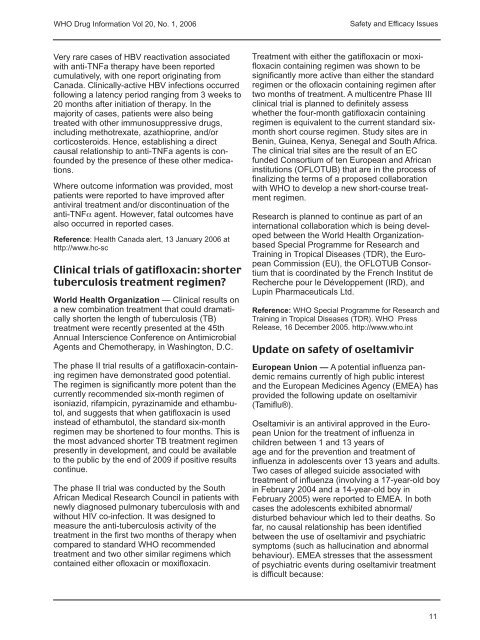WHO Drug Information Vol. 20, No. 1, 2006 - World Health ...
WHO Drug Information Vol. 20, No. 1, 2006 - World Health ...
WHO Drug Information Vol. 20, No. 1, 2006 - World Health ...
Create successful ePaper yourself
Turn your PDF publications into a flip-book with our unique Google optimized e-Paper software.
<strong>WHO</strong> <strong>Drug</strong> <strong>Information</strong> <strong>Vol</strong> <strong>20</strong>, <strong>No</strong>. 1, <strong>20</strong>06Safety and Efficacy IssuesVery rare cases of HBV reactivation associatedwith anti-TNFa therapy have been reportedcumulatively, with one report originating fromCanada. Clinically-active HBV infections occurredfollowing a latency period ranging from 3 weeks to<strong>20</strong> months after initiation of therapy. In themajority of cases, patients were also beingtreated with other immunosuppressive drugs,including methotrexate, azathioprine, and/orcorticosteroids. Hence, establishing a directcausal relationship to anti-TNFa agents is confoundedby the presence of these other medications.Where outcome information was provided, mostpatients were reported to have improved afterantiviral treatment and/or discontinuation of theanti-TNFα agent. However, fatal outcomes havealso occurred in reported cases.Reference: <strong>Health</strong> Canada alert, 13 January <strong>20</strong>06 athttp://www.hc-scClinical trials of gatifloxacin: shortertuberculosis treatment regimen?<strong>World</strong> <strong>Health</strong> Organization — Clinical results ona new combination treatment that could dramaticallyshorten the length of tuberculosis (TB)treatment were recently presented at the 45thAnnual Interscience Conference on AntimicrobialAgents and Chemotherapy, in Washington, D.C.The phase II trial results of a gatifloxacin-containingregimen have demonstrated good potential.The regimen is significantly more potent than thecurrently recommended six-month regimen ofisoniazid, rifampicin, pyrazinamide and ethambutol,and suggests that when gatifloxacin is usedinstead of ethambutol, the standard six-monthregimen may be shortened to four months. This isthe most advanced shorter TB treatment regimenpresently in development, and could be availableto the public by the end of <strong>20</strong>09 if positive resultscontinue.The phase II trial was conducted by the SouthAfrican Medical Research Council in patients withnewly diagnosed pulmonary tuberculosis with andwithout HIV co-infection. It was designed tomeasure the anti-tuberculosis activity of thetreatment in the first two months of therapy whencompared to standard <strong>WHO</strong> recommendedtreatment and two other similar regimens whichcontained either ofloxacin or moxifloxacin.Treatment with either the gatifloxacin or moxifloxacincontaining regimen was shown to besignificantly more active than either the standardregimen or the ofloxacin containing regimen aftertwo months of treatment. A multicentre Phase IIIclinical trial is planned to definitely assesswhether the four-month gatifloxacin containingregimen is equivalent to the current standard sixmonthshort course regimen. Study sites are inBenin, Guinea, Kenya, Senegal and South Africa.The clinical trial sites are the result of an ECfunded Consortium of ten European and Africaninstitutions (OFLOTUB) that are in the process offinalizing the terms of a proposed collaborationwith <strong>WHO</strong> to develop a new short-course treatmentregimen.Research is planned to continue as part of aninternational collaboration which is being developedbetween the <strong>World</strong> <strong>Health</strong> OrganizationbasedSpecial Programme for Research andTraining in Tropical Diseases (TDR), the EuropeanCommission (EU), the OFLOTUB Consortiumthat is coordinated by the French Institut deRecherche pour le Développement (IRD), andLupin Pharmaceuticals Ltd.Reference: <strong>WHO</strong> Special Programme for Research andTraining in Tropical Diseases (TDR). <strong>WHO</strong> PressRelease, 16 December <strong>20</strong>05. http://www.who.intUpdate on safety of oseltamivirEuropean Union — A potential influenza pandemicremains currently of high public interestand the European Medicines Agency (EMEA) hasprovided the following update on oseltamivir(Tamiflu®).Oseltamivir is an antiviral approved in the EuropeanUnion for the treatment of influenza inchildren between 1 and 13 years ofage and for the prevention and treatment ofinfluenza in adolescents over 13 years and adults.Two cases of alleged suicide associated withtreatment of influenza (involving a 17-year-old boyin February <strong>20</strong>04 and a 14-year-old boy inFebruary <strong>20</strong>05) were reported to EMEA. In bothcases the adolescents exhibited abnormal/disturbed behaviour which led to their deaths. Sofar, no causal relationship has been identifiedbetween the use of oseltamivir and psychiatricsymptoms (such as hallucination and abnormalbehaviour). EMEA stresses that the assessmentof psychiatric events during oseltamivir treatmentis difficult because:11

















